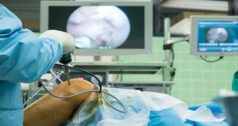
Sales in the sports medicine segment eclipsed $6.7 billion in 2023 and accounted for 11.4% of the $59 billion global orthopedic market, according to ORTHOWORLD estimates. ORTHOWORLD reports that the market’s worldwide sales will reach $7.1 billion in 2024 and $8.4 billion by 2027.
In 2023, Stryker’s broad product portfolio and focus on the ASC market allowed the company to capture nearly 13% of the sports medicine market and reach $887 million in sales, 10% more than the previous year.
“Orthopedic ASCs are buying across product lines,” said Stryker CEO Kevin Lobo. “They are buying capital, disposables and implants. That definitely plays to our advantage because we’re very deep within these service lines.”
Arthrex and Smith+Nephew continued to pace the segment, however, with $2.2 billion and $1.5 billion in sales and 34% and 23% market share, respectively.
ORTHOWOLRD noted that sports medicine case volumes slowed slightly in 2023 amid persistent supply shortages and as orthopedic companies focused on keeping pace with increasing joint replacement demand. Still, ORTHOWORLD said that improving procedure volumes in sports medicine will lead to the market’s full recovery.
Additionally, research presented at this year’s American Academy of Orthopaedic Surgeons Annual Meeting reported that sports-related injuries in individuals over the age of 65 are expected to increase by 123% from 2021 to 2040.
“In practice, we are seeing older adults participating in activities that weren’t previously of interest to them, such as pickleball,” said Jay Zaifman, M.D., lead author of the study and orthopedic surgery resident at NYU Grossman School of Medicine. “We now need to consider the new higher demands of many of these patients. Taking a patient-centered approach and rethinking our standard of care for more active older adults is crucial.”
Nathan Skelley, M.D., a fellowship-trained sports medicine surgeon at Sanford Health and the University of South Dakota School of Medicine, believes the sports medicine market will be defined by the continuous pursuit of performing increasingly complex procedures through smaller incisions. He said orthopedic surgeons must constantly tap available resources to stay informed about the latest surgical technologies, buy into data-driven care to determine ways to improve patient outcomes and be willing to learn and adapt to the latest trends.
“I’m particularly excited by recent advancements in enhanced visualization systems that provide clearer images during arthroscopic procedures, as well as the emergence of biologics and devices that complement mechanical repairs,” Dr. Skelley said.
Improved Healing Power
Biologics are becoming increasingly relevant in sports medicine, Dr. Skelley noted. He said Arthrex has made significant strides with platelet-rich plasma (PRP) and bone marrow aspirate concentrate (BMAC) systems for hip core decompression surgery.
Additionally, MTF Biologics has introduced CartiMax, a treatment for cartilage defects in the knee. “This technology is particularly exciting because it simplifies the tedious process of suturing in cartilage grafts,” Dr. Skelley said. “CartiMax offers a more straightforward approach — it’s a putty that can be applied directly into defects. Histologic studies have demonstrated its ability to promote the growth of hyaline cartilage, which is the ultimate goal.”
CartiMax currently needs to be applied through open incisions, but there’s hope that surgeons will eventually transition to applying it during arthroscopic surgeries. “This advancement holds immense promise for the field and hopefully, we’ll witness its implementation in minimally invasive procedures in the next few years,” Dr. Skelley said.
CONMED’s BioBrace is also an intriguing application. It contains bovine collagen reinforced with PLLA and functions as a bioinductive implant. Essentially, it offers mechanical strength and biological healing potential. Presented results involving the implant are promising and highlight the additional value of using biologics to augment mechanical repairs.
The Maryland-based startup CelestRay Biotech has received FDA 510(k) clearance for the SpinMedix Absorbable Fibrous Membrane, which is indicated for the management and protection of tendon injuries in which there has been no substantial loss of tendon tissue. This implantable synthetic membrane, made of biodegradable polymers, wraps around a ruptured tendon during its repair. The membrane helps prevent the scarring of the tendon that could impede its ability to slide naturally.
“The company’s membrane is formed through electrospinning,” said Robert Briber, Ph.D., Special Assistant to the President for Strategic Initiatives and Associate Dean for Research at the University of Maryland’s A. James Clark School of Engineering. He provided polymer expertise to the product’s development. “CelestRay can control both the porosity and thickness of the material, and at a certain temperature, it spontaneously curls up and wraps the tendon to be repaired. Surgeons will not have to roll it themselves or glue it.”
Enabling Technology Enhancements
Advanced imaging and navigation technologies have proven useful in sports medicine applications, according to Dr. Skelley. He said Stryker’s HipMap has revolutionized his approach to hip arthroscopy. The system employs CT scans to create 3D models of bone impingement locations and alignment of the hip joint. It provides Dr. Skelley with a wealth of information that guides his approach during surgery.
“Before having access to the technology, I often felt like I was operating blindly — relying solely on x-rays, CT scans and dynamic examinations in the operating room to detect impingements and other pathology within the joint,” he said. “Now, HipMap lays out that critical information before I enter the operating room.”
“I used to follow a standardized approach to procedures, moving from one step to the next in a predictable manner,” Dr. Skelley said. “However, now I find myself adjusting my techniques based on the needs of individual patients.”
For example, HipMap might inform him that he needs to position the portal higher to access a specific location due to known impingement issues or allocate additional operative time to address a pincer lesion identified on the MRI.
“Although we haven’t conducted formal research on the benefits of personalized surgical approaches, I have observed anecdotally that patients tend to have better outcomes when approaches are tailored to address specific pathology present in the hip,” Dr. Skelley said. “This underscores the importance of compiling patient data and conducting a retrospective review to further investigate these observations.”
Dr. Skelley believes that the emergence of virtual reality (VR) and augmented reality will transform surgical training by offering a more immersive and realistic learning experience for the next generation of surgeons. He calls the use of the technologies a “significant development.”
In February, Osso VR released Hand Control, a controller-free option designed to complement and enhance the training capabilities that are available during VR training scenarios.
“We’re all in on creating a super-realistic setup for surgeons using our devices,” said Justin Barad, M.D., Founder and CEO of Osso VR. “Think of Hand Control as an extra tool in their toolbox, helping them learn and train with maximum realism and impact. It allows surgeons to replicate precise movements and techniques.”
Minimally Invasive Approaches
Dr. Skelley and his colleagues won an Orthopedic Video Theater Award at this year’s AAOS Annual Meeting for demonstrating an alternative arthroscopic approach that preserves hip capsule anatomy.
The traditional method of performing hip arthroscopy involves making large capsulotomies, which compromise the integrity of the robust ligaments surrounding the hip joint. Dr. Skelley said this can lead to hip instability and trauma to the joint’s tissue post-surgery. Additionally, he said repairing the capsule at the end of the procedure is tedious and time-consuming, often adding up to 30 minutes to the surgery.
In contrast, Dr. Skelley’s approach utilizes a portal approach through small incisions, starting in the peripheral compartment with an intact capsule. He said the minimally invasive surgery allows the arthroscopic fluid to fill the capsule like a balloon, providing a clear view and workspace within the joint.
“Starting in the peripheral compartment provides direct visualization of the femoral head, reducing the risk of damaging the labrum or cartilage during the procedure,” Dr. Skelley noted. “This approach promises safer surgery, faster recovery time, less postoperative pain and more effective outcomes for patients with hip arthritis.”
One of his patients recently returned for a follow-up visit after undergoing the procedure. The patient is a student athlete, and his teammates had similar surgeries performed by another surgeon who still uses the traditional approach involving large capsulotomies.
Dr. Skelley’s patient experienced a quicker recovery and less postoperative pain than his teammates.
“This experience highlights how surgical techniques are evolving and the ways in which we are pioneering minimally invasive approaches to hip arthroscopy,” he said. “It’s gratifying to witness these advancements in our field, and it reinforces my passion for innovation and practice in this space.”
DC
Dan Cook is a Senior Editor at ORTHOWORLD. He develops content focused on important industry trends, top thought leaders and innovative technologies.




